Warehouse Safety Line Painting Guide and OSHA Floor Marking Standards
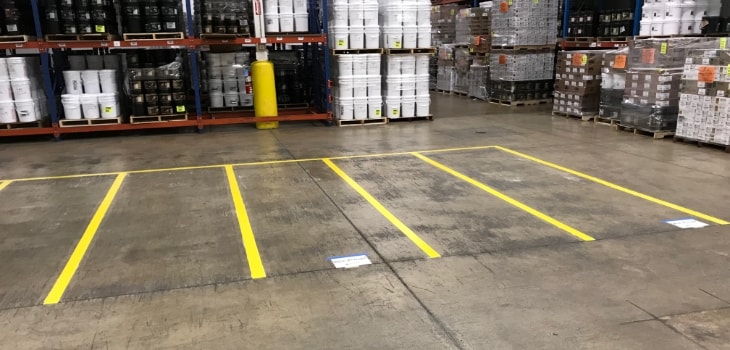
Warehouse safety floor markings are extremely useful in dividing spaces and offering visual cues for the proper flow of traffic, as well as indicate areas where caution should be a priority. From dots to stripes, lines to shapes, professional floor marketing contractors throughout the U.S. keep risks at a minimum with their safety floor marking services.
Well-organized spaces are the earmarks of all successful warehouse managers who want to keep the work flowing at the right pace and without risk of injury. OSHA floor marking guides help dictate what is necessary in warehouses throughout the U.S. Warehouse managers often draft floor plans of their own, but they take OSHA regulations into account while establishing a guide for efficient and safe traffic flow.
And while painting safety lines in a warehouse helps employees avoid hazards, floor markings are also a source of information that provides visual cues that make their jobs easier. At Painters Inc., we’re here to provide our warehouse clients with every resource they need for a successful floor marking project.
Check out the following to figure out which is best for you:
- What is warehouse floor marking and striping?
- Why is floor line marking important for warehouse facilities?
- Where floor marking can be used?
- OSHA floor marking regulations and industry standards
- OSHA floor marking guidelines for warehouses
- OSHA color requirements for warehouse floor marking
- What are the line width requirements?
- Floor marking paint vs. floor marking tape
- Important line marking tips for your warehouse facility
What is warehouse floor marking and striping?
Warehouse floor marking, also called warehouse line striping, is the process of marking the floor with paint, usually a high-wear epoxy, or tape. Tape is generally thought of as a temporary fix, whereas using high-quality epoxy paint is a more durable and long-lasting solution.
The essential purpose of warehouse floor marking is to create a separation in spaces, including outlining various workstations or storage areas. The markings are also used to point out various hazards. Furthermore, floor markings help to direct the flow of traffic, such as defining pedestrian traffic vs. forklift lanes, etc.
Floor marking professionals take direction from OSHA regarding colors that indicate various hazards and meanings. For example, yellow indicates areas where caution needs to be applied while white indicates areas where various types of equipment are to be placed.
Why is floor line marking important for warehouse facilities?
The safety of employees is of paramount concern with warehouse owners, which is the #1 reason warehouse floor line markings exist. These markings identify areas and/or objects that pose potential risks, thereby keeping everyone safe.
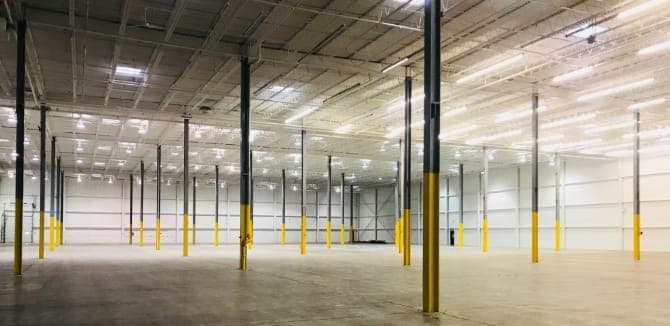
Another top reason floor line markings exist in warehouses is that they direct traffic, which helps to improve the way employees navigate their surroundings. They are also used to identify boundaries and item locations.
With the majority of warehouses utilizing forklifts, floor markings are vastly important, as accidents involving these heavy machines and pedestrians are of major concern. It is estimated that around 20,000 people are injured in forklift incidents every year. The introduction of floor markings can help to prevent a majority of these incidents.
While the safety of workers is important, floor markings also prevent collisions with structure and products in a facility, which minimizes costs associated with such accidents. When bright and bold lines are marked throughout a facility, forklift drivers are far less likely to make errors.
At Painters Inc., we know first-hand how important floor markings are in protecting employees and property, and we have the skills necessary to keep your facility up to code.
Warehouse floor line repainting
Regardless of how durable warehouse safety lines are when expertly applied, there comes a time when they need to be repainted. Floor line repainting is a specialty of ours at Painters Inc. We provide the services warehouse owners/managers need to create clear pathways for traffic, whether it’s pedestrian or motorized.
Over time, dirt and grime build up on warehouse line markings, making them less visible to employees. The lines can also be completely worn off if not painted correctly, which is another reason to inspect your warehouse line painting and make the necessary repairs. Don’t let your floor markings be an afterthought – bring in Painters Inc. for floor line repainting today.
Benefits of line striping for warehouse facilities management
Warehouse floor striping offers a host of benefits, including improved safety. When you add line striping to your warehouse floor or have it repainted, employee safety will improve. It is our experience at Painters Inc. that when we provide services to our clients, their productivity improves, because with clearer boundaries, traffic flows more efficiently.
The following are some of the top reasons warehouse floor markings are important:
- Warehouse organizational improvement
From indicating where various products or equipment is to be placed to outlining storage areas, floor markings make employees aware of exactly where items go, thus improving organization and workflow. - Lean and 5S methodologies
Need assistance following your 5S standards? When you have floor markings professionally installed, you have a much easier time following lean and 5S methodologies. Whether it’s keeping bulk items organized or using space more efficiently, warehouse floor striping is the key to success. - Traffic direction
Separating motorized traffic from foot traffic is one of the major benefits of line striping. Whether it’s forklift lanes or pedestrian pathways and intersections, properly applied floor markings lead to safer and more efficient environments. - Warehouse personal protection equipment (PPE)
In areas of the warehouse where hardhats or other protection is required, the proper markings can be installed to alert anyone in the area that they need to wear personal protection equipment. - Placement of objects
When everything is in the right place, things run much smoother. Floor striping informs employees where everything should go, whether it’s a trash receptacle or pallet, products or equipment, having this organizational aid installed at your facility will help you reach production goals.
Where can floor markings be used?
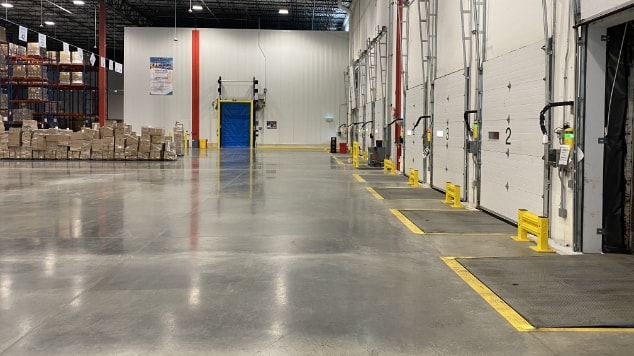
From travel lanes to restricted areas, utilizing high visibility floor markings in your factory is not only an OSHA requirement for worker safety, it’s also a means for improved workflow. The following are examples of OSHA floor striping requirements:
- Pedestrian traffic lanes
- Vehicle traffic lanes
- Areas where hazardous materials belong
- Recharging stations for forklifts
- Loading dock warning tracks
- Clearance indications for safer turns
- Emergency exit guides
When you partner with Painters Inc., you get a painting contractor that is knowledgeable of all the regulations regarding floor marking colors, each having different meanings. Our floor marking services have assisted many clients in keeping their employees safe and their production running smoothly.
Every facility is different, but they all require high-quality floor markings, including in the following:
- Slip/fall hazards
- Storage
- Loading docks
- Aisles
- Pedestrian lanes
- Intersections/crosswalks
- Forklift lanes
- Red tag (5S) zones
- Staging lanes
- Charging stations
- Hazardous areas
- Work cells
- Boundaries for electrical area
- Emergency paths
With Painters Inc. handing your floor marking project, you can rest assured that every OSHA regulation will be followed and the project will be completed with exceptional results.
OSHA floor marking regulations and industry standards
One of the most crucial components for achieving workplace safety goals includes OSHA floor markings. When you follow industrial floor marking guidelines, you create a leaner facility that operates at a far safer level. Utilizing a color-coded system, factory floor marking standards make employees and visitors aware of safety risks throughout the facility. Everything from hard hat zones to the location of fire extinguishers are clearly identified, as directed by OSHA floor marking guidelines.
Some areas of warehouses and factories are more prone to accidents. These are areas that can be lined with yellow and black paint, alerting anyone in the area that they need to proceed with caution. Similarly, red is used to identify potential fire risks and zones where flammable materials are stored. Painters Inc. is a painting contractor educated in everything there is to know about floor marking guidelines and will install yours with an eye for the finest details.
Here’s a look at what OSHA has to say about floor marking and how it can improve efficiency and increase safety in your warehouse facility.
OSHA Standard 1910.176(a): Use of mechanical equipment
“Where mechanical handling equipment is used, sufficient safe clearances shall be allowed for aisles, at loading docks, through doorways and wherever turns or passage must be made. Aisles and passageways shall be kept clear and in good repair, with no obstruction across or in aisles that could create a hazard. Permanent aisles and passageways shall be appropriately marked.”
OSHA Standard 1910.144: Safety color code for marking physical hazards
- "1910.144 Red shall be the basic color for the identification of fire protection equipment and apparatus, containers of flammable liquids, stop buttons and electrical switches used for emergency stopping of equipment.
- 1910.144(a)(1) Red shall be the basic color for the identification of fire protection equipment and apparatus.
- 1910.144(a)(3) Yellow shall be the basic color for designating caution and marking physical hazards."
OSHA Standard 1910.35: Compliance with alternate exit-route codes
“OSHA will deem an employer demonstrating compliance with the exit route provisions of NFPA 101, Life Safety Code, or the exit route provisions of the IFC 2009, to be in compliance with 1910.34, 1910.36 and 1910.37.”
OSHA Standard 1910.22(b): Marking and width requirements for aisles in industrial operations
“As a result of numerous calls regarding the marking and widths of aisles in industrial operations, the following are considered to comply with the requirements:
- The lines used to delineate the aisles may be any color so long as they clearly define the area considered as aisle space. The lines may be composed of dots, square, strip or continuous, but they too must define the aisle area.
- The recommended width of aisle markings varies from 2 inches to 6 inches; therefore, any width 2 inches or more is considered acceptable.
- The recommended width of aisles is at least 3 feet wider than the largest equipment to be utilized, or a minimum of 4 feet.”
OSHA floor marking guidelines for warehouses
OSHA floor marking guidelines help to maintain a consistent protocol from one facility to another. For example, the warehouse floor marking guidelines dictate how aisles and passageways need to be marked. The following is a description of the various areas where Painters Inc. applies these guidelines and why they are important for the continued safety of employees and efficient workflow.
Mark permanent aisles and passageways
Confusion exists in busy facilities where people and machinery are in motion, but the floors are not clearly marked. When a facility has aisles defined by floor striping, employees know where it is safe for pedestrians to walk and where motorized traffic belongs. Furthermore, clearly defined passageways can lessen the confusion that would otherwise exist.
Clearly mark traffic flow areas
Confusion exists in busy facilities where people and machinery are in motion, but the floors are not clearly marked. When a facility has aisles defined by floor striping, employees know where it is safe for pedestrians to walk and where motorized traffic belongs. Furthermore, clearly defined passageways can lessen the confusion that would otherwise exist.
Create employee-only areas
Without floor striping, non-employees can easily enter restricted areas that are meant for employees only. This can lead to potentially dangerous situations. Whether it’s an area with high shelving where items can fall and injure someone or if it’s an area where hazardous material is stored, floor markings can alert non-employees to stay out.
Paint safety lines as exit guides
In the event of an emergency and a fast exit is required, installing floor markings that indicate the direction to the nearest exit is a great way to keep everyone safe. Even for employees familiar with the layout of a facility, having these markings as a reminder can be of great assistance.
At Painters Inc., we follow OSHA guidelines when installing floor markings. Furthermore, we work with our clients who operate warehouses, factories and other industrial facilities to make sure anything outside of the purview of OSHA guidelines is followed and that all areas that need to be clearly defined are handled professionally.
OSHA color requirements for warehouse floor marking
Floor marking color standards have helped establish consistency for highly-visible lines that are understood at a glance. OSHA color requirements serve as a valuable guideline in planning future floor marking projects. Colors have different designations and a quality painting contractor is aware of all of them. A prime example is using the color red in areas where fire hazards exist, but it also indicates the location of fire extinguishers. It’s also a universal standard that yellow and black striped markings alert people of potential health hazards in the area.
Facilities throughout the U.S. follow the same warehouse floor marking standards. It’s something that has been established and adopted over the last few decades and today is nearly universally followed in all facilities and all painting contractors. The following chart explains the use of the various colors.
Yellow
Aisleways, traffic lanes and work cells
White
Equipment and fixtures not otherwise color coded (workstations, carts, floor stand displays, racks and machines, etc.)
Blue / green / black
Raw materials, finished goods, and works in progress.
Orange
Inspection areas for products and materials, energized equipment
Red
Defects, scrap, rework and 5S red tag areas
Red and white
Areas to be kept clear for safety/compliance reasons (areas in front of electrical panels, firefighting equipment and safety equipment, such as eyewash stations, safety showers and first aid stations)
Black and white
Areas to be kept clear for operational purposes (not related to safety and compliance)
Black and yellow
Areas that may expose employees to special physical or health hazards
Using the right floor marking colors
Every successful floor marking project begins with an understanding of the meaning behind each of the colors. The following are descriptions of what some of the colors and combinations of colors designate in the industrial environment.
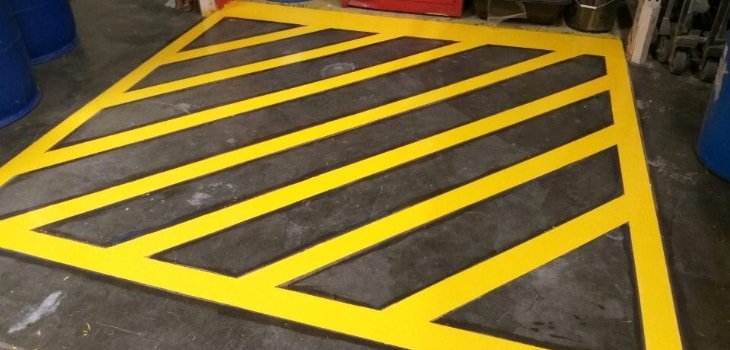
Yellow lines for walkways and traffic flow
Similar to the yellow lines in some roadways, yellow line markings in factories indicate routes for traffic. To clear up any confusion regarding types of traffic, pedestrian and motorized lanes can be differentiated by using icons that indicate one vs. the other. Yellow is also used for outlining a workspace/workcell.
White lines for equipment storage zones and racking
Safe and orderly storage of various equipment helps companies operate more smoothly. Using white lines to segment individual storage bays achieves this goal. Whether it’s on the floor or tiered shelving, white lines provide a border indicating the proper space for various types of equipment.
Yellow & black lines for caution and safety hazard markings
Black and yellow lines staggered diagonally indicate areas where caution needs to be practiced. They are often used in areas of the warehouse where hazardous material or machinery is located. Black and yellow lines are also used to point out trip hazards, a prime example being the edge of raised platforms. Fast-moving equipment or machinery, electrical stations and volatile material areas are also commonly adorned with black and yellow lines.
Blue, green and black lines for raw materials, works in progress and finished goods
While a combination of all three colors, blue, green and black, can be used to indicate works in progress, finished goods and raw materials, it is recommended to use only one of the colors to avoid confusion. After selecting a color, use icons to be more specific about what type of material it is.
Red for red tag areas marking
Red tags are most often used to indicate defective inventory. It’s also used to mark rework and scrap. Following 5S best practices, red tags are used to tag equipment or products whose immediate use is unclear, so red is also used in areas where these red-tagged items are stored.
Orange for holding materials
When items are held for inspection, either final inspection or an inspection required before it can progress to the next step of production, they are held in areas marked by orange lines.
Red & white for safety or compliance
The combination of red and white lines indicates areas that individuals need to stay clear of, either for compliance or safety reasons. The most common use of the red and white lines is around eyewash stations and equipment used for fighting fires.
Black & white for operations and workflow
Black and white lines are used in areas where individuals need to keep clear of because of workflow or operations activity. The use of black and white lines is not a safety precaution, just a productivity issue.
A professional painting contractor with experience in floor markings will also take measures to ensure areas of the floor that could become slippery when wet are secured with a non-slip surface. That’s what we offer at Painters Inc. Furthermore, we place color charts in the facility to help educate employees, ensuring they know what each color indicates.
We assist our clients in adopting floor marking standards and we install the lines with colors that are consistent with OSHA regulations. Furthermore, we use the right paint and tools for the job, which means the work we do will last for a long time.
What are the line width requirements?
OSHA requirements state that lines must be at least two inches in width. However, in large facilities, it is recommended to paint lines three to four inches wide. Going wider in larger spaces brings more attention to the lines and prevents potential problems.
Floor marking paint vs. floor marking tape
At Painters Inc., we only use paint, as it lasts longer than tape. Some facilities will lay down tape as a temporary fix or while planning where permanent markings will go. For a more permanent solution that will hold up to the rigorous environment of a warehouse, epoxy paints are the go-to method of marking floors.
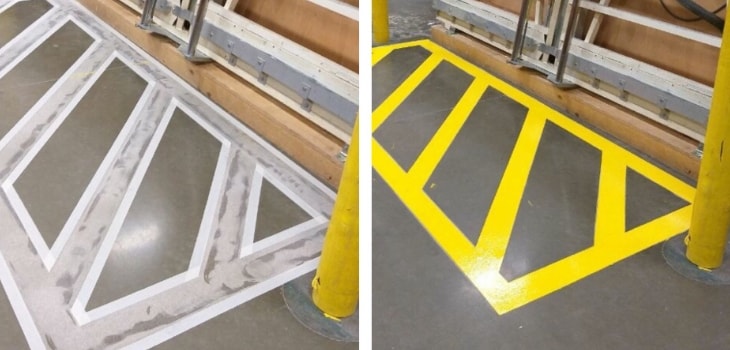
Floor paint
Floor paints come in all the colors OSHA recommends for floor markings. Using the right application methods, a painting contractor can lay the paint on just about any surface. Fortunately, floor paint is engineered to last a long time, resist fading and chipping.
In areas of heavy traffic and after years of abuse, such as impact with metal lifts and forklifts, even the most expertly applied paint will wear down. It is recommended to carefully monitor these areas and have them repainted as soon as damage is noticed.
Floor marking tape
Floor marking tape is generally made of vinyl and has an industrial adhesive that ensures it bonds with a clean surface. Tape comes in a variety of colors and can even be made with a reflective quality. Some tapes are made with glow-in-the-dark properties for low- to no-light situations.
Most facilities that install floor marking tape do so as a temporary solution. While most tape is made to be durable, it is not as long-lasting as paint and will become marred/damaged faster.
At Painters Inc., we’re focused on making our painting jobs last a long time, which is why we use high-quality floor paints. If your facility is currently marked with tape, contact us and let’s talk about the advantages of installing a more permanent solution.
Important line marking tips for your warehouse facility
From proper planning to cleaning, moving equipment and testing paint products, there are several things you can do to make your warehouse floor marking project a success. The following are some tips you should follow to make sure you don’t encounter mistakes and delays.
Plan ahead and create a workable solution
All successful projects begin with a strong strategy. Fortunately, some of the heavy lifting is already done for you, as most safety standards are already drawn up for you. Given that no two warehouses are exactly alike, you’ll need to apply these standards to your facility in the right way. Start by creating a blueprint, which will help highlight potential areas of concern and allow you a chance to come up with a solution.
Test the logistics of your plan
Before you make a permanent floor marking with paint, it’s always smart to test your plan first. When you run a few efficiency tests, you’ll see where improvements to your plan can be made. This testing phase also allows you to try a few different things and get an idea of which one works best. Be sure to involve your employees, as they will be the ones who have to follow the floor markings on a daily basis and can offer vital input.
Decide whether you need permanent or temporary line markings
In some cases, you’ll need to determine if a permanent line is required or if you should only use a temporary floor marking. For example, in warehouses where change is a regular occurrence, such as in facilities that are evolving at a fast pace, it might be more advantageous to use tape until a more permanent solution can be applied. In other cases, you’ll know that either the entire floor or a section of it will need paint, at which point you can make arrangements on the colors, paint types and whether or not you will seal it.
Clear out all debris and notify employees
A floor-marking project is a perfect time to take stock of the items in your warehouse, because before paint can be applied, things will have to be moved. Furthermore in order for paint to adhere properly, the floor must be completely clean. This is an opportunity to remove debris and make your facility clutter free. Be sure to warn employees in advance of the project, as they’ll need to stay clear of the areas being cleared, cleaned and painted and be careful not to walk or drive over freshly-painted lines.
Hire a professional line marking and striping company
Floor marking projects require a high degree of expertise, as there are many standards that must be followed. Mistakes can lead to confusion, accidents, damage and injury. At Painters Inc., we have years of experience painting floor markings in a variety of facilities, from warehouses to factories and all types of industrial properties.
We know that all jobs are different, so we communicate with each of our customers and devise a plan that is customized to meet their needs. Our painters have a keen eye for details, which is highly important in floor marking projects. Our customers know us as a contractor that finishes every job on time and on budget. Learn more about what we offer by contacting us today.









